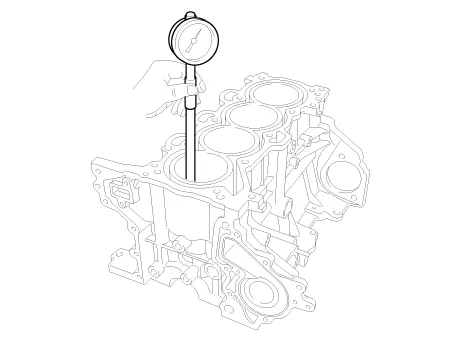Kia Optima DL3: Cylinder Block / Cylinder Block
Repair procedures
| Disassembly |
|
|
| 1. |
Remove the engine assembly from the vehicle. (Refer to Engine and Transaxle Assembly - “Engine and Transaxle Assembly”) |
| 2. |
Remove the transaxle assembly from the engine assembly. (Refer to Automatic Transaxle System - "Automatic Transaxle") |
| 3. |
Remove the drive plate. (Refer to Cylinder Block - "Drive Plate") |
| 4. |
Remove the rear oil seal. (Refer to Cylinder Block - “Rear Oil Seal”) |
| 5. |
Install the engine to engine stand for disassembly. |
| 6. |
Remove the timing chain. (Refer to Timing System - “Timing Chain”) |
| 7. |
Remove the water pump assembly. (Refer to Cooling System - “Water Pump”) |
| 8. |
Remove the water inlet fitting and the thermostat assembly. (Refer to Cooling System - “Thermostat“) |
| 9. |
Remove the intake manifold. (Refer to Intake and Exhaust System - "Intake Manifold") |
| 10. |
Remove the A/C compressor. (Refer to Heating, Ventilation Air conditioning -"Compressor") |
| 11. |
Remove the exhaust manifold. (Refer to Intake and Exhaust System - "Exhaust Manifold") |
| 12. |
Remove the cylinder head assembly. (Refer to Cylinder Head Assembly - "Cylinder Head") |
| 13. |
Remove the oil filter. (Refer to Lubrication System - “Engine Oil”) |
| 14. |
Remove the oil screen. (Refer to Lubrication System - “Oil Pan”) |
| 15. |
Remove the piston and connecting rod assemblies. (Refer to Cylinder Block - "Piston and Connecting Rod") |
| 16. |
Remove the crankshaft. (Refer to Cylinder Block - "Crankshaft") |
| 17. |
Remove the knock sensor. (Refer to Engine Control/Fuel System - "Knock Sensor (KS)") |
| 18. |
Remove the crankshaft position sensor (CKPS). (Refer to Engine Control/Fuel System - "Crankshaft Position Sensor (CKPS)") |
| 19. |
Remove the oil pressure switch. (Refer to Lubrication System - "Oil Pressure Switch") |
| Inspection |
| 1. |
Remove gasket material. Using a gasket scraper, remove all the gasket material from the top surface of the cylinder block. |
| 2. |
Clean cylinder block Using a soft brush and solvent, thoroughly clean the cylinder block. |
| 3. |
Inspect top surface of cylinder block for flatness. Using a precision straight edge and feeler gauge, measure the surface contacting the cylinder head gasket for warpage.
|
| 4. |
Inspect the cylinder bore Visually check the cylinder for vertical scratches. If deep scratches are present, replace the cylinder block. |
| 5. |
Inspect the cylinder bore diameter. Using a cylinder bore gauge, measure the cylinder bore diameter at position in the thrust and axial direction.
|
| Reassembly |
| 1. |
Assemble the other parts in the reverse order of disassembly. |
In case the cylinder block is replaced with a new one, select the proper crankshaft main bearing and the piston according to the crankshaft journal bore mark and the cylinder bore mark on the cylinder block.
|
Components and components location Components 1. Crankshaft upper bearing 2. Crankshaft thrust bearing 3. Crankshaft 4.
Components and components location Components 1. Camshaft bearing cap 2. Camshaft front bearing cap 3. Exhaust camshaft 4.
Other information:
Kia Optima DL3 2019-2025 Service and Repair Manual: Air Conditioning System
General safety information and caution Instructions (R-134a) When Handling Refrigerant 1. R-134a liquid refrigerant is highly volatile. A drop on the skin of your hand could result in localized frostbite. When handling the refrigerant, be sure to wear gloves.
Kia Optima DL3 2019-2025 Service and Repair Manual: Mode Control Actuator
Components and components location Components Location 1. Mode control actuator Description and operation Description The mode control actuator is located at the heater unit. It adjusts the position of the mode door by operating the mode control actuator based on the signal of the A/C co
Categories
- Manuals Home
- Kia Optima Owners Manual
- Kia Optima Service Manual
- Power Train
- Restraint
- Features of your vehicle
- New on site
- Most important about car




